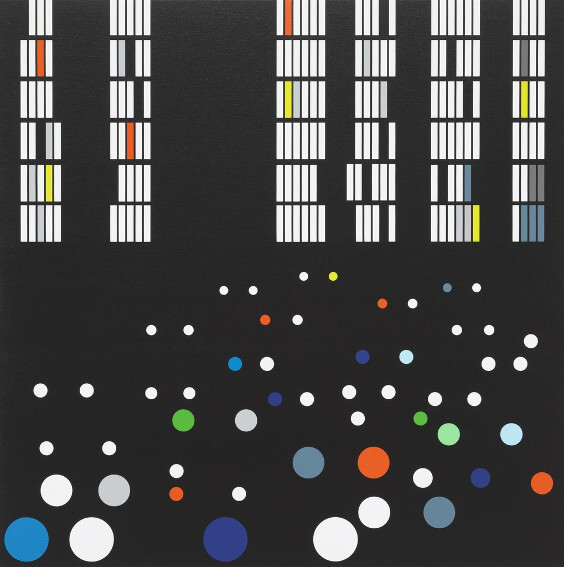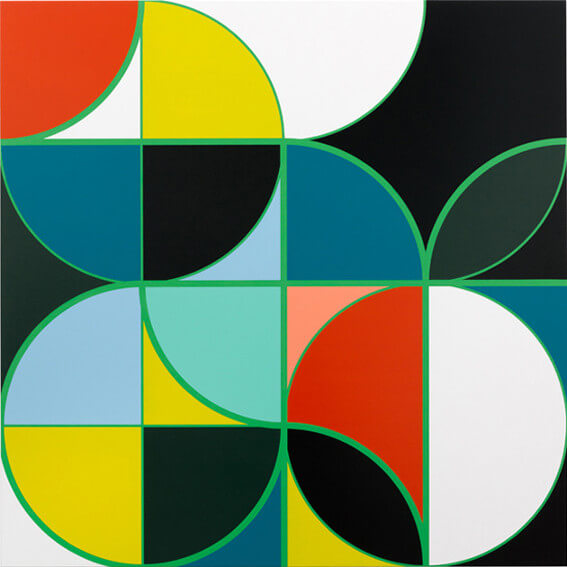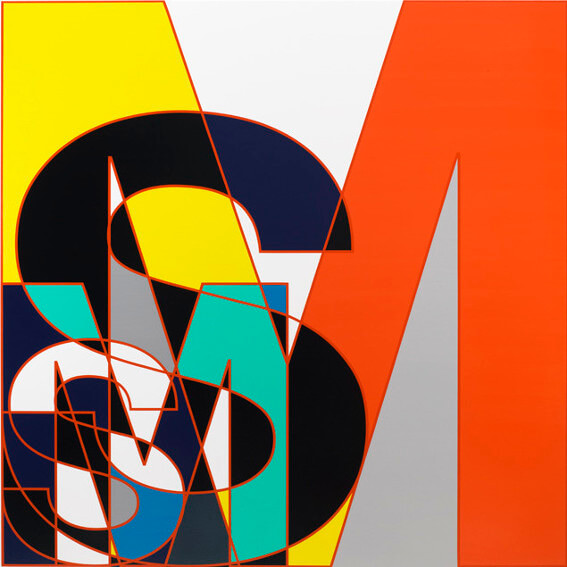
The Many Sides of Sarah Morris’s Art
If I was asked to list the most subversive abstract artists of our time, Sarah Morris would be near the top of the list. Morris makes films and paintings. She employs the language of typology in both. Typology is the study of like things. As an abstract artistic tendency, it has its roots in the 1950s, in the work of Bernd and Hilla Becher. The Bechers noticed anonymous architectural vernaculars popping up in the modern world. Structures like water towers, barns, factories and smokestacks all seemed to take on similar physical characteristics. No one in particular could be said to have invented these characteristics. But as their photographs showed, the forms were repeated incessantly by society. So common is the typology of an urban water tower that anyone who has ever lived in a city could draw one and it would look basically the same. But where did the form come from, and why must it look that way? These are just some of the issues the Bechers raised. They are also some of the issues at the heart of why the work Sarah Morris has been doing for the past 20 years is so subversive. Morris travels the world making non-narrative films of cities. She then uses the typologies that emerge in the films to construct abstract languages that she then uses to make large-scale typological paintings. The films and paintings reveal unsettling aesthetic underpinnings that are capable of inducing anxiety in viewers. They scream the visual language of the cities from which they emerge. That language is not complimentary—it is chaotic, brash, claustrophobic, and revelatory of an overwhelming power structure that enforces itself on the human spirit. For that reason, I was surprised to hear that the first-ever complete retrospective of the films of Sarah Morris is about to go on view at the Ullens Center for Contemporary Art in Beijing, from24 March through 17 June 2018. At a time when China is embracing the concept of singular visions enforced by leaders with absolute political power for life, the message Morris brings is a call for the pendulum to swing in the opposite direction.
The Nostos Effect
The title of this exhibition is Sarah Morris: Odysseus Factor. It is a reference could be interpreted in many ways. One obvious reading is that it refers to the amount of time Morris has spent making her films, which is 20 years. The exhibition opens on the 20thanniversary of the year she made Midtown (1998), her first film, which was shot in Manhattan. The opening also marks the ten-year anniversary of Beijing (2008), which Morris shot with permission during the Beijing Olympic games. Twenty years, spread out over two subsequent ten-year periods, which conclude with a return to a place she was before—this was also the story of Odysseus, who fought for ten years in the Trojan War, and then spent ten more years suffering an epic, distraction-filled journey home.

Sarah Morris - Metropolis, 2017, Silkscreen on Coventry Rag Paper, 24 × 24 in, 61 × 61 cm, Edition of 38, Swiss Institute, New York, © Sarah Morris
Hidden within the chronological reference is another Odyssian nod—a reference to something called the Nostos. In literature, a Nostos is a theme related to a homecoming. It also relates to the struggle for heroes to retain their original identity, so that despite being tempted to change on their journey, they can still claim to be deserving of their status as a hometown hero when they return. Beijing could be seen as one protagonist of this exhibition. The film Morris shot there in 2008 highlights a time of immense optimism. The abstract paintings she made in conjunction with the film are riddled with groupings of brightly colored circles—Olympic rings. What is the identity of the culture Beijing embraced in 2008? How has that identity been tested during the journey of the past decade? Has Beijing given in to temptation? Has it fought to retain its heroic stature? This exhibition is an opportunity for Chinese viewers to address these questions for themselves.

style="text-align: center;">Sarah Morris - Academia Militar [Rio], 2013, Household Gloss Paint on Canvas, 214 x 214 cm, © Sarah Morris
Motifs of Colors, Shapes and Rhythms
Morris has aalso made 13 other films and bodies of paintings based on the typologies of other places.This exhibition will present all 14 films together for the first time, along with new monumental wall paintings that will encircle the custom built screening rooms in the center of the gallery. The analytical potential offered by this tour de force is immense. It not only represents a chance for local viewers to revisit their local typology; it is also a chance for all to merge the typological studies of Beijing with those Morris made of Rio de Janeiro, Abu Dhabi, Paris, Hamburg, Los Angeles, Washington DC, Chicago, Miami, and several other places. This is a chance to experience a comparative study of the visual power structures that have emerged around the globe in the past 20 years.

class>style="text-align: center;">Sarah Morris - SM Outlined [Initials], 2011, Household Gloss Paint on Canvas, 214 x 214 cm, © Sarah Morris
It is tempting to believe that each global city has its own vernacular. Even if we feel oppressed by the visual motif of a city like New York—the darkened streets, the imposing skyscrapers, the cacophonous overcrowded streets—we can still love it because it is “so New York.” But what if the typology of New York is not unique. What if a unified, and oppressive visual language has emerged, which exists in all cities today? Morris reveals such insidious structures in her work. Her disquieting soundtracks and stoic editing techniques highlight for us the mundanity of our urban surroundings, as well as the hypnotic power they wield over our senses. It is a pleasantly subversive thought that this retrospective is targeting Beijing at this moment in history. But I hope it will travel afterward to every city in which Morris has made a film. Each deserves its Nostos—a chance to examine its visual character, so as to discover whether it is a hero, and whether there is anything worth coming home to at all.
Featured image: Sarah Morris - Acal [Sao Paulo], 2014, Household Gloss Paint on Canvas, 122 x 122 cm, © Saraf Morris
All images used for illustrative purposes only
By Phillip Barcio






